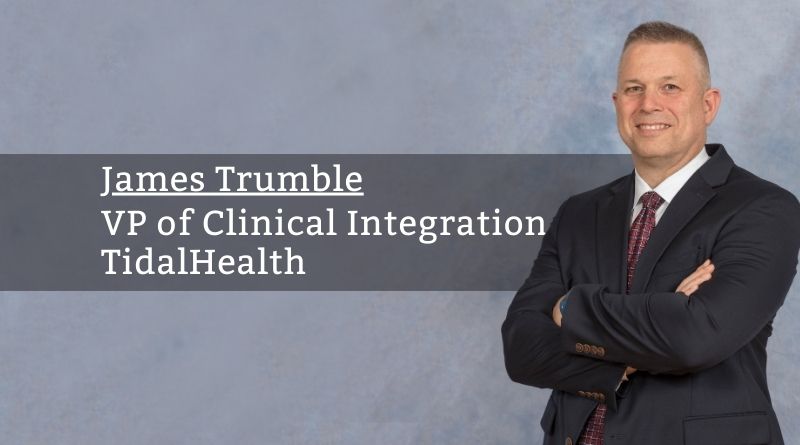What can Artificial Intelligence (AI) do for Population Health?
By James Trumble, VP of Clinical Integration, TidalHealth
Artificial intelligence (AI) and population health are relative newcomers as tools and approaches to change healthcare. AI is the next large disruption, already creating novel approaches to medications and medical diagnoses. The potential exists for a future that includes cures for cancer, Parkinson’s, and other debilitating and historically deadly diseases through the use of AI. Although healthcare, as an industry, tends not to adopt new technologies quickly, AI has the potential to further effectiveness and efficiency. Despite this benefit, population health has gained less from this technology than other industries and other areas of healthcare.
Improvements in population health often depend on process changes and how patients, staff, practitioners, and leadership in healthcare integrate those processes. Creating guidelines and protocol approaches through in-depth analysis produces predictive information and, potentially, reverses impacts that patients find most daunting to access, navigation, integration, and solutions to their healthcare world. Currently, information gained from Social Determinant of Health (SDoH) provides relative direction to address patient care concerns. Transportation, health literacy, neighborhood, and home environment, to name a few, impact patient care. However, this unidirectional approach considers how healthcare professionals take this information and react to manage the disease care process. Where this falls short is assessing how disease states affect social aspects of patient’s lives. An approach that is able to combine social, physical, disease state, education, work, and potentially other life issues must be inclusive and not a place to stop in the analysis.
For example, information such as X-rays, CT scans, or retinal images share a common theme for an AI program able to ingest image pixels and look for variations. Such programs do not suffer from fatigue, vision loss, distraction, or other human limitations. In the area of population health and clinical integration, we look for data to improve processes both for patients directly, as well as how practices collaborate with patients. Historically, many physicians saw themselves as providing services central to their practice, i.e., the patient comes to them. There was a lack of attention to the patient’s life issues. If they received a prescription or a referral to a specialist, it was up to the patient to see that through. More recently, healthcare has been more inclusive of patients. As we move into an environment where technology allows virtual visits, electronic prescriptions, and real-time information to patients, we must consider the many personal aspects that integrate into patient’s health.
AI is a platform from which the data and analysis, needed to improve healthcare, will be necessary going forward. Once established, there will be an exponential increase in health impact.
There is significant data available through Electronic Medical Records (EMRs), Health Information Exchanges (HIEs), and Insurance Companies. Procuring this data and sharing it for patient benefit, helps advance the analysis of patient needs. The early adopters of IT and AI industries figured this out. Large companies such as Google and Microsoft are openly sharing information with smaller companies to move AI forward. This, similarly, needs to be the process for healthcare. There is significant data available to train and validate programs, which will expand to other geographic and cultural features to create programs that are generalizable. SDoH is a focus of care coordination, wellness programs, and population health. However, our analysis needs to consider how SDoH interacts with disease management and treatment to affect each other, providing predictive insight into admissions, readmissions, future complications, and disease progression. In addition, a broad expanse of data could allow hindsight into a constellation of medical and social downward progression, and the ability to address a past concern (that still looms over the patient) to stop a circular process and reactive action of healthcare.
Certainly, areas of concern exist when addressing personal aspects of people’s lives. To create an AI and population health interface, we ask for information that patients may view as private. In addition, we need to be cognizant of data biases, regulatory restrictions, ethical considerations, and distrust. While going through data ingestion, training, and validation, we need to approach this in a stepwise and cross-validating manner to determine not only correlation but causation. Measures that may be redundant, convoluted, and cross-correlated would require separate confirmation and analysis for C-statistic or Area Under the Curve (AUC).
There is still significant doubt about AI. Even basic data and analysis comes with suspicion, not only from patients, but from physicians and other providers as part of the medical establishment. There is, also, comfort in how things exist. Even if a new technology or process provides an avenue for more efficiency and effectiveness, the learning curve is often viewed as a mountain not worth climbing. Population health, although more than 20 years old, is still considered something new to medicine and healthcare–areas often resistant to change. Yet, we already see the benefits of change to patient access and effectiveness through automation, but progress cannot stop. Having a mechanism that is generalizable and simplifying is necessary for stakeholders to accept as beneficial to all involved. AI is a platform from which the data and analysis, needed to improve healthcare, will be necessary going forward. Once established, there will be an exponential increase in health impact.



